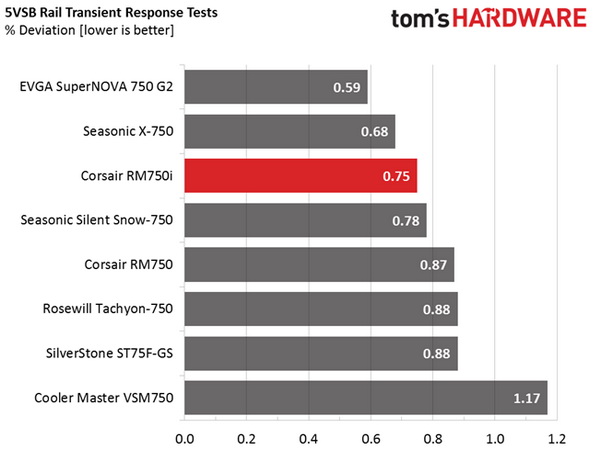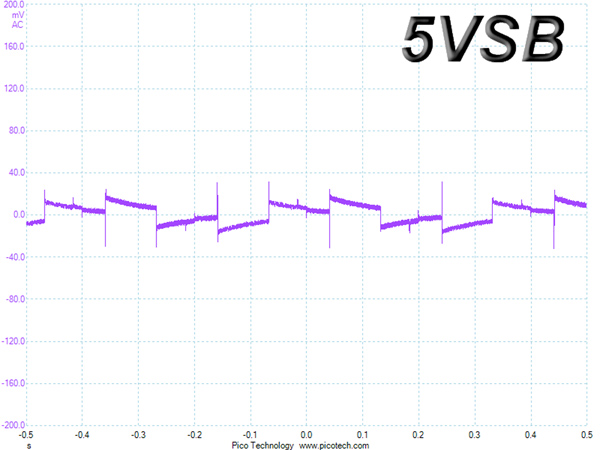Corsair RM750i Power Supply Review
Corsair is revamping its RM line, adding the letter "i" to highlight a more advanced digital interface — today we check out the RM750i.
Why you can trust Tom's Hardware
Transient Response Tests
Advanced Transient Response Tests
For details on our transient response testing, please click here.
In these tests, we monitored the response of the PSU in two different scenarios. First, a transient load (10A at +12V, 5A at 5V, 5A at 3.3V and 0.5A at 5VSB) was applied to the PSU for 200 ms while the PSU was working at 20-percent load. In the second scenario, the PSU was hit by the same transient load while operating at 50-percent load. In both tests, we used our oscilloscope to measure the voltage drops caused by the transient load. The voltages should have remained within the ATX specification's regulation limits.
These tests are crucial because they simulate the transient loads a PSU is likely to handle (such as booting a RAID array, an instant 100-percent load of CPU/GPUs, etc.). We call these tests "Advanced Transient Response Tests," and they are designed to be very tough to master, especially for a PSU with a capacity of less than 500W.
Advanced Transient Response At 20 Percent
| Voltage | Before | After | Change | Pass/Fail |
|---|---|---|---|---|
| 12V | 12.087V | 12.021V | 0.55% | Pass |
| 5V | 4.999V | 4.940V | 1.18% | Pass |
| 3.3V | 3.331V | 3.238V | 2.79% | Pass |
| 5VSB | 4.977V | 4.945V | 0.64% | Pass |
Advanced Transient Response At 50 Percent
| Voltage | Before | After | Change | Pass/Fail |
|---|---|---|---|---|
| 12V | 12.041V | 11.973V | 0.56% | Pass |
| 5V | 4.992V | 4.935V | 1.14% | Pass |
| 3.3V | 3.325V | 3.232V | 2.80% | Pass |
| 5VSB | 4.961V | 4.919V | 0.85% | Pass |





The performance of the RM750i during our Advanced Transient Response Tests was superb. This platform can easily handle any transient load you'll throw at it, and on the +12V rail, the voltage drop was very low in both cases. Even the 3.3V rail managed to stay within 3 percent, registering a very good performance compared to the competition.
Here are the oscilloscope screenshots we took during Advanced Transient Response Testing:
Transient Response At 20 Percent Load




Transient Response At 50 Percent Load
Turn-On Transient Tests
In the next set of tests, we measured the response of the PSU in simpler transient load scenarios during the PSU's power-on phase.
For the first measurement, we turned off the PSU, dialed in the maximum current the 5VSB could output and switched on the PSU. In the second test, we dialed the maximum load the +12V could handle and started the PSU while it was in standby mode. In the last test, while the PSU was completely switched off (we cut off the power or switched off the PSU by flipping its on/off switch), we dialed the maximum load the +12V rail could handle before switching on the PSU from the loader and restoring the power. The ATX specification states that recorded spikes on all rails should not exceed 10 percent of their nominal values (+10 percent for 12V is 13.2V, and 5.5V for 5V).
Get Tom's Hardware's best news and in-depth reviews, straight to your inbox.



We noticed a tiny voltage overshoot at 5VSB and a small wave in the waveform during the last test. That's certainly not perfect performance, but it's still good enough for a high-end PSU, as there weren't any high- or medium-voltage overshoots or spikes.
Current page: Transient Response Tests
Prev Page Cross-Load Tests And Infrared Images Next Page Ripple Measurements
Aris Mpitziopoulos is a contributing editor at Tom's Hardware, covering PSUs.